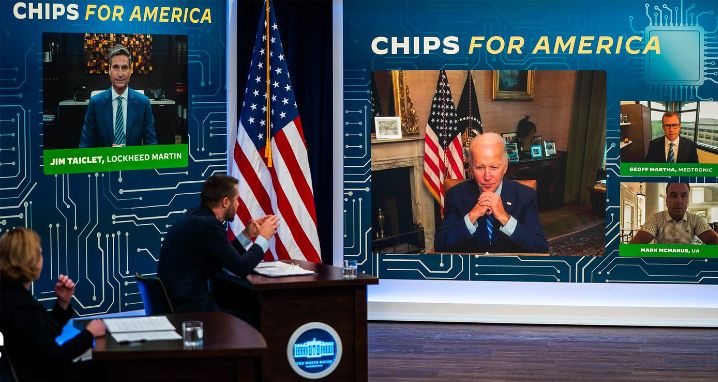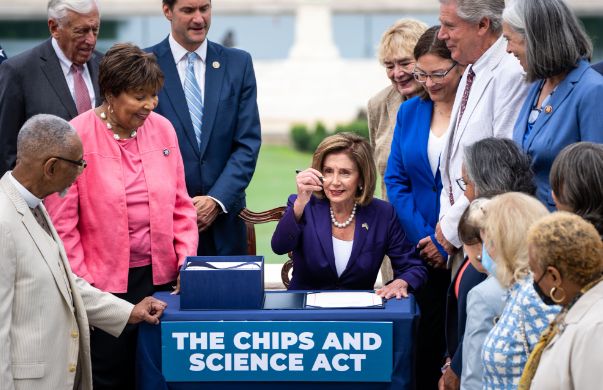By Eric Vandenbroeck
and co-workers
When the U.S.
Congress passed the CHIPS and Science Act in August 2022, it committed $53 billion
to fund semiconductor research and manufacturing in the United States. As a
result of this legislation, advanced chip manufacturers have been racing to
build new U.S. factories. Since then, however, it has quickly become apparent
that more than fabrication capacity is needed to make the United States a
semiconductor powerhouse. What the country needs is raw materials or capital.
The primary constraint is a shortage of talent.
According to
projections, U.S. semiconductor companies will have 300,000 unfilled vacancies
for skilled engineers by 2030. Targeting, training, and recruiting hundreds of
thousands of U.S. citizens will be impossible in such a compressed time frame.
The only way to meet this demand is to recruit more skilled workers abroad. This
should not be a problem: the United States has long relied on its companies and
universities to attract the best and brightest. Brilliant engineers from all
around the world helped me turn Google into a world-leading technology company.
But this did not happen because of the U.S. immigration system. It happened
despite it. For decades, Washington has failed to pass meaningful immigration
reform. If the United States wants to remain the world leader in
innovation, it can no longer afford to ignore the talent waiting beyond its
borders.
Innovation power—the
ability to invent, adopt, and adapt new technologies to advance national
power—will determine the future of geopolitics. And this ability to
innovate depends, above all, on the strength of a country’s talent pool.
U.S. professional sports leagues understand this: basketball and baseball
scouts scour the globe to find the best players for their teams. But when
recruiting the world’s top AI scientists and semiconductor engineers, the U.S.
immigration system has put up unnecessary barriers. Current restrictions are
increasingly putting the United States behind countries with points-based
immigration systems, like Canada and the United Kingdom, which are aggressively
courting advanced tech workers and engineers.
The United States is
still the world’s most attractive country for immigrants. Its university system
is the world's envy, and its companies lead the world in innovation. But
suppose Washington wants to stay ahead and achieve the promise of the CHIPS and
Science Act. In that case, it must act to remove the needless complexities to
make its immigration system more transparent and create new pathways for the
brightest minds to come to the United States.

The Battle For Brains
While the United
States' dysfunctional system increasingly deters the world’s top scientists,
researchers, and entrepreneurs, other countries proactively recruit them. China
is particularly active in doing so, with direction coming from the top. 2021
President Xi Jinping declared that “the competition of today’s world
is a competition of human talent and education.” At his instruction, the nation,
which suffers from an exodus of talent, began to spend serious money to woo
back native-born STEM graduates. Today, Chinese research institutions offer
some postdoctoral researchers three times the salaries they could make at a
U.S. university. Skilled Chinese engineers and scientists who previously moved
abroad to work are being provided powerful incentives to return home.
U.S. allies have
significantly stepped up efforts to bring in the best talent. Last year, United
Kingdom Prime Minister Rishi Sunak announced a scheme to target and attract the
world’s top 100 young AI researchers. The United Kingdom now has a High
Potential Individual visa program specifically aimed at graduates of the
world’s top universities. In 2015, Canada created an Express Entry system,
which allows high-skilled foreign nationals to become permanent residents in
only a year. The results are already showing: between 2016 and 2019 alone, the
number of Indian STEM masters students studying in Canada rose by 182 percent.
During the same period, the number of Indian students studying in the same
fields in the United States dropped 38 percent.
To compete in the
decades to come, the U.S. economy must attract high-skilled immigrants who will
build future technologies, from large language models to quantum computers. Its
complex and restrictive immigration rules put off many talented workers who
want to come to the United States. These rules mainly affect foreign students,
who currently make up over 70 percent of U.S. graduate students in computer
science. Upon graduation, international students who wish to remain and
contribute to the U.S. economy usually seek to do so by applying for an H-1B
visa. But H-1B visas are allotted not on a candidate’s relative talent but
through a random lottery with a success rate as low as 11 percent. Most foreign
U.S.-trained Ph.D. graduates in artificial intelligence who consider leaving
the country cite its immigration system as a main reason. Although U.S.
universities continue to train many of the most capable scientists and
engineers globally, other countries are increasingly enjoying the benefits.
There is broad
bipartisan support for common-sense immigration reform. Yesterday, 70
experts and former national security officials published an open letter calling
on the House Select Committee on the Chinese Communist Party to attract and
retain global STEM talent to maintain U.S. leadership in technology. Last
year, in a poll conducted by the Economic Innovation Group, 60 percent of
Republicans and 83 percent of Democrats supported more skilled immigration to
the United States. Seventy-three percent of the U.S. public favor a visa
allowing international graduates in STEM subjects to work in the United States.
Lawmakers on both sides of the aisle have made proposals to increase U.S.
competitiveness by attracting more high-skilled foreign workers. But these
proposals have been blocked year after year. Last year, there was bipartisan
support for making available additional green cards with shorter wait times for
STEM PhDs. Yet, ultimately, this initiative was stripped from the final
National Defense Authorization Act.
Still, there are
various ways to make targeted changes with the backing of both parties. Today,
for example, even a physics or math Ph.D. from the United States’ best
universities—precisely the type of person needed to spur innovation and
scientific discovery—has no clear path toward residency in the country.
Congress should address this problem by creating a conditional green card for
STEM Ph. D.s, perhaps initially focusing on U.S. partner countries. This visa
would give recipients permanent residence for two to three years, with an
extension option upon review. There is precedent for creating such a unique
entry program: conditional green cards have been successfully used for investor
visas, and the United States has, at various times, tailored visas toward
nationals of allied countries. Perhaps the most notable example is the E-3
visa, which applies to specialist workers from Australia and could be expanded
to other nations. This new green card would make the immigration process for
STEM Ph. D.s more streamlined and predictable. It would also remove pressure on
other visa categories with numerical limits and country caps and allow green
card holders to move freely between jobs. At the same time, this new green card
should come with sensible restrictions, limiting eligibility to a recognized
list of leading research institutions.

The Competition For The World’s Top Scientists
The United States needs
to retain and attract international talent to win the global talent
competition. As Harvard political scientist Graham Allison and I have argued,
the U.S. government should make a concerted effort to identify and recruit top
researchers from across the globe. A unique green card for exceptional
scientists would allow the United States to maintain its edge in technology and
help it confront the tremendous geopolitical challenges of the coming years.
The U.S. government
has a successful history of using such a strategy in the decades around World
War II. In the 1930s and 1940s, the United States attracted a generation of
talent, including luminaries like Albert Einstein and Enrico Fermi. The two
left Nazi Germany and fascist Italy before coming to the United States, where
their research and other émigré scientists were instrumental to the Manhattan
Project. Today, Washington needs to do more to attract leading scientists from
nonaligned or hostile countries, even if doing so requires more extensive security
screening. The United States missed a significant opportunity last year when
U.S. President Joe Biden could not persuade Congress to waive visa
requirements for top Russian engineers and scientists seeking to escape
President Vladimir Putin’s rule. The United States should also do more to
attract Chinese scientists and innovators, who have been a massive boon to the
U.S. economy. Since 2000, Chinese STEM Ph. D.s have created startups valued at
over $100 billion. If Washington wants innovators to start their businesses in
the United States rather than China, it must be more welcoming to Chinese
talent. Although much has been made in Washington of the security risks posed
by a few foreign researchers accused of intellectual property theft, far more
significant harm will be done to the country over the long term by keeping out
entrepreneurial Chinese scientists.
Washington must also
make it easier for the world’s top entrepreneurs to come to the United States.
More than half of U.S. companies valued at over $1 billion were founded or
co-founded by immigrants. But, unlike in Canada and Australia, there is no
designated startup visa for entrepreneurs who want to find a business in the
United States. Congress should resurrect an earlier CHIPS and Science Act version
that would have created a new visa category for startup founders. And that is
only the start. Several other visa classes should be made, including ones for
foreign nationals of high aptitude who, in return for residency, agree to work
for federal or state governments in areas that most need immigration. Similar
to pathways to citizenship for those enrolling in the U.S. military, the United
States should use new visas to draw exceptional talent into local government.
There are already
signs of progress. The State Department plans to make it easier for millions of
international professionals to renew their visas without traveling abroad. The
department should also relax requirements for the J-1 visa, which requires most
holders to return to their home countries and stay there for at least two years
before they can return to the United States.
The global contest
for talent is too important to hold up these reforms for an elusive bipartisan
immigration grand bargain. Hard though it will be, opening up more pathways for
highly skilled workers to enter the United States will be vital to preserving
and promoting national competitiveness and security. Without such changes, the
promise of the CHIPS and Science Act will remain unfulfilled. The power of the
American dream has long allowed the United States to attract the best and the
brightest. This advantage rests on Washington’s ability to field the best team
for the coming geopolitical competition. The United States cannot afford to
lose it.
For updates click hompage here